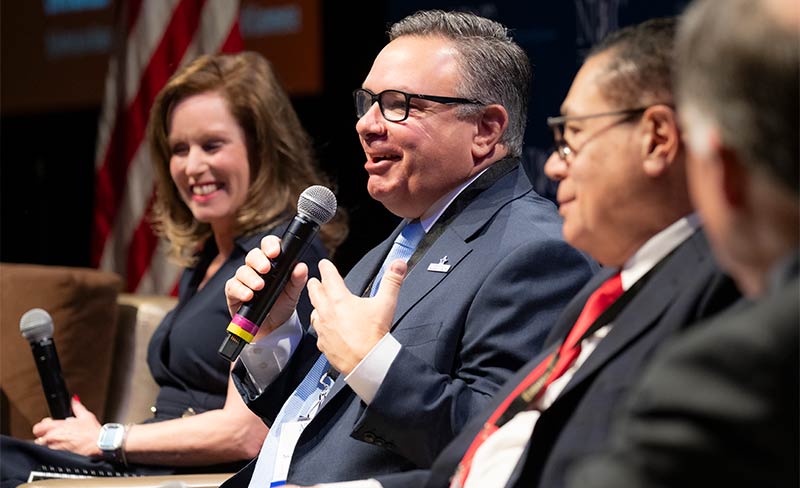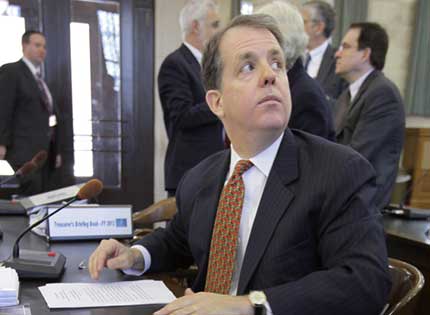While Gov. Chris Christie is still several weeks away from announcing his proposal to overhaul New Jersey’s pension and retiree health benefits system, his plan seems most likely to center on a “hybrid” model that would give current employees a smaller defined-benefit payoutsupplemented by a 401K-style defined contribution plan.
Christie, who was forced to make a $2.4 billion cut in the state’s pension contribution last week to balance the budget, has repeatedly made it clear that he believes the only way out of the state’s deepening pension crisis “is to stop the insanity of a defined-benefit pension system that we cannot afford.”
The problem, Treasurer Andrew Sidamon-Eristoff told the Senate and Assembly budget committees last week, is that a “hard cutover” from the current defined benefit plan to a 401K-style defined contribution for current employees would actually increase the state’s annual pension bill because employee contributions are needed to help amortize the system’s $54 billion unfunded liability.
However, Sidamon-Eristoff said “there are ways to phase in” the transition from a defined-benefit system -- under which retirees are guaranteed a set monthly check based on their five years of highest pay and number of years worked -- to a 401K-style defined contribution system that could convert into an annuity based upon how much is in the account at retirement.
Sidamon-Eristoff said Christie administration officials have been analyzing pension reform plans in various states for “many months.” He emphasized that the final decision on pension reform would be made by Christie, but he specifically cited the hybrid pension system that Rhode Island’s independent governor and Democratic Legislature approved in 2011 as “an interesting model that bears analysis” in an Assembly Budget Committee hearing last Wednesday. Under the Rhode Island plan, state employees with less than 20 years of service who paid 8.5 percent toward their traditional defined-benefit pensions now continue to pay 3.5 percent toward their regular pensions, but put the other 5 percent into a 401K-style defined contribution plan with a choice of mutual funds.
Gov. Lincoln Chafee later backtracked on some of the pension changes -- “much to my disappointment,” Sidamon-Eristoff noted – in an effort to avoid a lawsuit by the public employee unions, but the unions sued anyway. A trial is scheduled for September -- the same month that the plan’s author, Treasurer Gina Raimondo, is favored to win a Democratic primary for governor that is being dominated by the pension issue.
“We’ll know by the fall whether the Rhode Island plan holds up in court or not,” said Eileen Norcross, the top pension expert at George Mason University’s Mercatus Center. “Rhode Island’s the only state so far that has created a combined defined-contribution and defined-benefit system for current employees, not just new hires. The advantage is that it switches some of the risk to the employees, and it reduces the unfunded liability.”
Four other states -- Tennessee, Virginia, Georgia, and Utah -- have also passed hybrid plans that reduce defined-benefit pensions for new employees, and either require or allow employees to pay into 401K-style defined-contribution plans, theNational Association of State Retirement Administrators (NASRA) noted in a study last month.
“Michigan switched to a defined-contribution plan for new hires in 1997 knowing that it would face a problem 20 years down the road,” Norcross noted. “But when you have a short time horizon and a large liability, as New Jersey does, your options are limited.”
Part of the challenge is that New Jersey already has enacted significant pension changes.
Christie and Senate President Stephen Sweeney (D-Gloucester) declared that they had put New Jersey’s pension system on the road to solvency in 2011 when they teamed up to push through legislation that saved $74 billion over 30 years by cutting retiree cost-of-living increases -- a cut that is being challenged in court by the state’s unions -- and another $48 billion by requiring employees to pay more toward their pensions, reducing pensions for those taking early retirement, and raising the retirement age from 62 to 65.
The 2011 law followed one year after passage of an equally important law committing the state to a seven-year ramp-up to the full actuarially required pension payments by Fiscal Year 2018 to make up for 15 years of underfunding of the state’s pension system by Democratic and Republican governors and legislatures alike.
It was that earlier law that Christie decided to ignore when he announced that he would retroactively cut the required third-year pension payment for FY14 from $1.58 billion to $696 million, and the scheduled fourth-year FY15 payment from $2.25 billion to $681 million to plug a $2.7 billion budget gap that suddenly emerged in April when income tax collections from wealthy taxpayers nosedived.
Sidamon-Eristoff last week billed the two-year pension cut as a necessary short-term fiscal maneuver and said the state intended to make a $2.5 billion payment in FY16, putting it on schedule to ramp up to actuarially required funding in 2019 -- one year behind schedule -- when the required payment would most likely top $5 billion.
But Senate Budget Chairman Paul Sarlo (D-Bergen) questioned last week how the Christie administration could possibly find enough money to increase the state’s pension payment next year from $681 million to $2.5 billion -- a funding jump that would probably exceed the total increase in state revenues that year.
Each year that the state fails to make the actuarially required payment, the unfunded pension liability grows. In fact, the state’s share of the total $54 billion unfunded liability for state and local government will grow from $38 billion to more than $40 billion over the next year just as a result of the pension payment cuts Christie announced last week. Further, the portfolio’s funded ratio will drop from 53.72 percent to 50.8 percent, Sidamon-Eristoff acknowledged.
Christie started the drumbeat for further pension and retiree healthcare cuts in January when he declared that soaring pensions, retiree health benefits and debt-service costs were eating up 94 percent of the revenue increase in this year’s budget.
While Christie originally planned to push for pension and retiree health benefit changes as part of his FY16 budget plan next January, April’s budget crisis, thedowngrading of the state’s credit rating by all three bond rating agencies, and the need to cut the pension payments led him to speed up his timetable.
Christie is now promising to unveil a comprehensive plan to cut pension and retiree health benefits costs in mid-June, but his options are limited.
The governor already has eliminated cost-of-living increases for retirees, and while courts in other states have upheld such cuts, no court has upheld the elimination of pension benefits already accrued by retirees or current employees whose pensions are fully vested.
The only exceptions occurred when Detroit, Central Falls, RI, and Pritchard, AL, were allowed to cut benefits for both retirees and current employees when they went into bankruptcy, Norcross said. However, state governments are considered sovereign entities with the power to raise taxes and are not allowed to declare bankruptcy -- despite Christie’s repeated warnings that New Jersey’s pension liabilities threaten to make the state “the next Detroit.”
That leaves pension changes for current employees as Christie’s most logical target, whether through implementation of a hybrid pension system along the lines of Rhode Island, by requiring higher pension payments, or by further raising the retirement age, which is already 65.
“There’s an issue of intergenerational equity that comes into play,” Norcross said. “You have a cohort of retirees who get pretty decent benefits, current employees pay more and get less, and then there’s the question of what you offer the new hires. And to what extent do you expect current employees to pay for the generous benefits of retirees, knowing that they will never get the same benefits? It’s a difficult issue, and I don’t envy anyone who had to navigate all that.”
The transition to hybrid pension plans is likely to increase in popularity because it keeps some employee contributions flowing into the pension system to cover the liability of current retirees, while cutting the long-term unfunded liability by shifting a portion of the future pension liability for current employees or new hires to 401K-style defined-contribution plans that can be turned into fully funded annuities upon retirement.
The incentive for employees is that if their investments do better than expected, their ultimate pension payments could be higher than if they had remained in a traditional defined-benefit system, according to “Effects of Pension Plan Changes on Retirement Security” -- a study conducted by researchers from NASRA and the Center for State and Local Government Excellence.
Hybrid pension systems can be constructed in such a way that retirees have the possibility of receiving higher pension payouts, as is the case in Rhode Island, Tennessee, and Utah, or as part of a plan to drastically cut future pension payments, as was the case in Virginia and Georgia, the study found.
Since 2009, when state revenues plummeted nationwide in the wake of the Great Recession, 45 states have made changes to their pension systems by increasing employee contributions, reducing pension benefits, jacking up the retirement age, or expanding the number of salary years used in final pension calculations to lower the payout, the National Conference of State Legislatures reported.
Actual pension benefits were reduced in 23 states by a low of 1.2 percent in Massachusetts and Texas to a high of 20 percent in Pennsylvania and Alabama, with New Jersey posting a 10.9 percent reduction.
Pension payments are the product of a “final average salary” multiplied by years of employment multiplied by a set percentage. New Jersey’s pension cut resulted from a decision to base the final average salary on an average of the top five salary years -- rather than the top three -- and a reduction in the multiplier percentage from 1.818 percent to 1.66 percent.
Christie has been saying since January that he wants current employees to pay more toward their pensions. However, the 2011 law raised the percentage of income paid toward pensions by police and firefighters -- who are allowed to retire after 20 years under state law -- from 8.5 percent to 10 percent. It also boosted the pension payments of teachers and other state and local government workers from 5.5 percent to 6.5 percent; they will then rise steadily over seven years to 7.5 percent in FY18.
Sweeney, Assembly Speaker Vincent Prieto (D-Hudson), and other Democratic legislative leaders have said they do not want to ask public employees to pay more when the state once again is failing to meet its obligation to make the ramped-up pension payments required under the 2010 law.
Both the New Jersey Education Association and the Communications Workers of America have already threatened to file lawsuits to compel the state to make its required pension payments.





